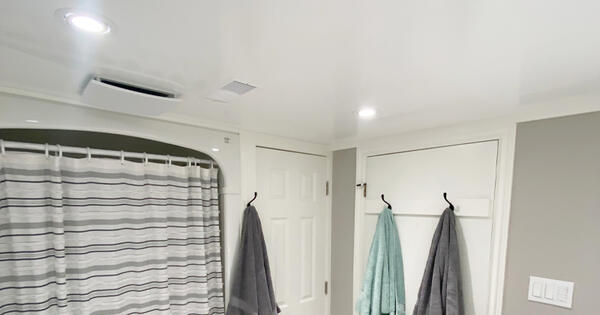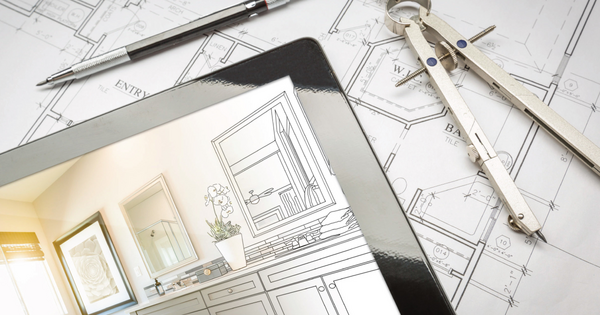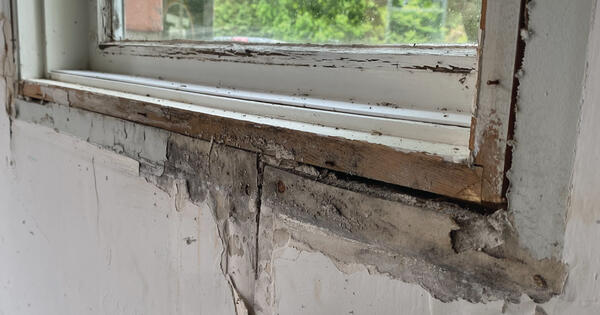Bathrooms are unlike any other space in your home. They’re constantly exposed to high humidity, splashes of water, and rapid temperature changes — all of which create a demanding environment for building materials. Choosing the right materials isn’t just about aesthetics; it’s about ensuring durability and long-term functionality.
Using the wrong materials in a bathroom renovation can lead to serious consequences. Materials not designed to withstand moisture can quickly deteriorate, losing their strength and structural integrity. Worse, they can create conditions perfect for mold growth, which not only damages your home but also poses potential health risks.
The Problem with Drywall in Bathrooms
At first glance, drywall might seem like a simple, cost-effective solution for bathroom walls and ceilings. However, it’s far from ideal for spaces with constant moisture exposure. Drywall — specifically the standard variety — is not water-resistant. Its paper surface and gypsum core readily absorb water, making it highly susceptible to damage in humid environments.
When drywall absorbs moisture, it can create the perfect conditions for mold growth. Mold spores thrive in damp, dark spaces, and once they take hold, they can spread quickly, leading to unsightly stains and potentially affecting indoor air quality.
Even in a well-ventilated bathroom, drywall’s lifespan is significantly reduced compared to other moisture-resistant materials. Over time, humidity causes the material to weaken, warp, or crumble, which means frequent repairs and replacements for homeowners. While water-resistant drywall variants, like green board, exist, they’re still not entirely waterproof — making them only marginally better in high-moisture areas.
Water Damage and Mold Growth Risks
Drywall is particularly vulnerable to water damage. Over time, even minor exposure to moisture can cause it to swell, sag, or crumble. In severe cases, drywall becomes soft and structurally unstable, requiring full replacement.
When drywall is exposed to prolonged moisture, mold growth is almost inevitable. Signs of mold behind drywall can include visible discoloration, a persistent musty smell, or peeling paint and wallpaper. In more severe cases, you may not notice mold until you open up the wall, revealing black or green patches on the surface.
The cost of repairing water-damaged drywall varies depending on the extent of the damage, but it’s rarely inexpensive. Homeowners can expect to spend hundreds — or even thousands — of dollars to remove and replace damaged sections, address any underlying water issues, and remediate mold problems. These repairs aren’t just costly; they’re time-consuming and can disrupt your daily life.
Maintenance and Repairs: The Hidden Costs of Drywall
Drywall might seem like a cost-effective choice initially, but the ongoing maintenance it requires in bathrooms can quickly outweigh the savings. Bathrooms are high-moisture environments, and drywall simply isn’t built to handle that level of exposure over time.
Drywall in bathrooms often requires frequent repairs. Even with precautions like paint or sealants, moisture can still seep through and cause:
- Cracks and splits in the surface, which weaken the structure and make the walls look unsightly.
- Peeling paint or bubbling wallpaper, signs that water has infiltrated the material.
- Sagging or crumbling sections that need to be patched or entirely replaced.
Replacing drywall in bathrooms can become an expensive cycle. While minor repairs might only cost a few hundred dollars, replacing entire sections due to water damage or mold can run into the thousands. This doesn’t account for additional expenses, like addressing underlying water issues or hiring mold remediation specialists.
In contrast, alternative materials designed for wet environments require far less upkeep. By investing in water-resistant or waterproof materials, homeowners can significantly reduce long-term maintenance costs and avoid the frustration of repeated repairs.

Better Building Material Alternatives to Drywall for Bathrooms
When renovating a bathroom, choosing materials designed for high-moisture environments is crucial. Unlike drywall, which absorbs water and deteriorates, several alternatives offer superior performance and durability.
Some of the best materials for bathroom walls include:
- Tile: A classic choice, tile is water-resistant and easy to clean. It comes in a wide range of styles, but professional installation can make it more expensive.
- Cement board: Often used as a base for tile, cement board is highly durable and resists moisture better than drywall. It’s not as visually appealing on its own but provides a sturdy foundation.
- PVC panels: These lightweight panels are waterproof, mold-resistant, and simple to install, making them a practical option for bathrooms.
- Acrylic or fiberglass panels: Commonly used for shower surrounds, these materials are seamless and easy to maintain but can be costlier upfront.
When comparing materials, consider:
- Durability: PVC and cement board are highly resistant to damage, while tile can crack if not installed properly.
- Cost: Tile and acrylic panels tend to be more expensive, while PVC and cement board are budget-friendly.
- Maintenance: Materials like PVC panels require minimal upkeep, while tile grout lines may need regular cleaning to prevent mildew.
Why Trusscore Wall&CeilingBoard is a Game-Changer for Bathrooms
Trusscore Wall&CeilingBoard is a modern solution that solves the challenges homeowners face with drywall in bathrooms. Unlike drywall, which absorbs moisture and invites mold, Trusscore panels are engineered to perform in wet and humid spaces.
Here’s what sets Trusscore apart:
- Waterproof and mold-resistant: Unlike drywall, Trusscore Wall&CeilingBoard is 100% waterproof and moisture resistant, and water will roll right off the panels. The interlocking tongue-and-groove system also means panels install with a watertight seal, so your wood framing or insulation are also protected. That means you’ll never have to worry about mold and mildew growing anywhere in the room.
- Simple installation: If you’re planning on renovating your bathroom yourself, Trusscore Wall&CeilingBoard is way more DIY-friendly than drywall. The pre-finished panels weigh 40% less than heavy sheets of drywall and install four times faster, with only one person needed for installation (even on tricky ceiling installs!). Plus, there’s no mudding, taping, priming, or painting required, so you can complete your project in a single afternoon.
- Low maintenance: The smooth, non-porous, and water-resistant properties of Trusscore Wall&CeilingBoard panels also make them a dream to clean. During your regular bathroom cleaning routine, you can wipe Trusscore Wall&CeilingBoard down with soap and water or disinfectant spray. Since no amount of cleaning will damage your panels, you can keep your bathroom fresh and free of bacteria.
Compared to drywall, Trusscore offers a superior combination of performance, aesthetics, and long-term value. It’s a solution designed not just to meet the demands of bathroom renovations but to exceed expectations.



Cost Considerations for Bathroom Wall Materials
When planning to update your bathroom walls, understanding the cost of materials is essential. Bathroom walls often endure high humidity and regular cleaning, which means choosing the right material can impact both your budget and long-term maintenance needs.
Average Costs for Common Wall Materials
Here’s a breakdown of estimated costs for various bathroom wall materials:
- Drywall: At $1.50 to $3.50 per square foot (materials and labor combined), drywall is one of the most budget-friendly options. However, standard drywall isn’t moisture-resistant, which could lead to costly repairs down the road in a humid environment like a bathroom.
- Moisture-Resistant Drywall: Also known as green board, this material costs $1.50 to $2 more per square foot than standard drywall. While it offers improved resistance to moisture, it’s still susceptible to water damage over time if not properly sealed.
- Tile: Ceramic or porcelain tile ranges from $7 to $25 per square foot for materials and installation. While pricier upfront, tile provides unmatched durability and resistance to water, making it ideal for bathrooms.
- PVC Wall Panels: PVC panels cost around $2.75 to $3.75 per square foot. These pre-finished panels are water-resistant, easy to clean, and require minimal maintenance, making them a cost-effective long-term investment.
- Acrylic Panels: Priced between $15 and $25 per square foot, acrylic panels offer a sleek, modern look and are highly resistant to water and mold. However, they require professional installation, which can increase labor costs.
Factors That Affect Installation Costs
The total cost of updating your bathroom walls isn’t just about the material price — several other factors come into play:
- Labor Costs: Depending on your location, labor rates can range from $2 to $6 per square foot for installation. Hiring skilled professionals ensures quality work, particularly for materials like tile or acrylic that require precision.
- Preparation Work: If existing walls need to be demolished or repaired before installation, expect additional charges for labor and disposal of old materials.
- Additional Features: Adding mold-resistant coatings or insulation behind the walls can raise costs but may save money on repairs over time.
- Size and Layout: A larger bathroom or complex layouts with many corners and fixtures will require more materials and labor, driving up overall expenses.
While upfront costs are a key consideration, remember to factor in long-term durability and maintenance. Choosing high-quality materials, especially in moisture-prone bathrooms, can reduce repair costs and extend the life of your walls. For instance, while drywall might be affordable initially, a more durable option like PVC or tile could prove more cost-effective over time.
Prioritizing the Right Bathroom Wall Material
Choosing the right bathroom wall material is about balancing durability, hygiene, and long-term value. With so many options available, it’s essential to focus on what matters most for your space — longevity, ease of maintenance, and compatibility with your bathroom’s conditions.
Start by assessing your bathroom’s needs:
- Humidity Levels: Opt for materials like PVC or tile that are water-resistant if your bathroom is prone to high moisture.
- Budget: Factor in both material and installation costs, but also consider long-term savings from low-maintenance options.
- Design Goals: If aesthetics are a priority, materials like tile or acrylic panels offer a modern, polished look, while PVC panels provide clean lines and a seamless finish.
- Lifestyle: Families may prioritize easy-to-clean surfaces, while individual homeowners might prefer sleek designs with minimal upkeep.
By weighing these factors, you can confidently select the material that will best serve your bathroom for years to come.






